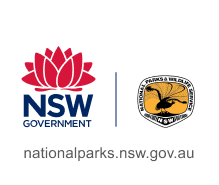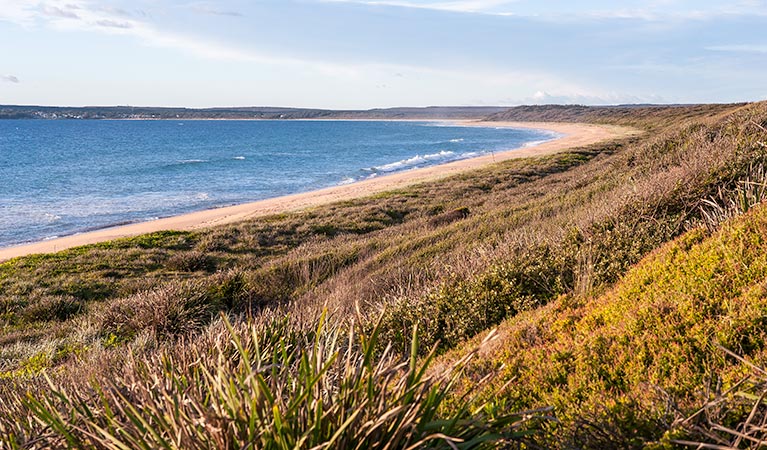Overview
Bull Hole lookout in Jervis Bay National Park offers scenic views of Warrain Beach, Beecroft Head, Currarong, Culburra, Mount Coolangatta and Crookhaven Bight.
- Type
- Lookouts
- Where
- Jervis Bay National Park in South Coast
- What to
bring - Hat, sunscreen, drinking water
- Please note
- Remember to take your binoculars if you want to go whale watching.
Stop by Bull Hole lookout in Jervis Bay National Park for expansive scenic views that take in Warrain Beach, Beecroft Head, Currarong, Culburra, Mount Coolangatta and Crookhaven Bight.
From the elevated viewing platform, you can enjoy outstanding views up and down the beach and of the surrounding dunes, which are covered in swamp oak, banksias and wattles.
The beach is popular with surfers and local fishermen, and the lookout is also a great spot from which to see dolphins frolicking in the waters year-round, or whales during migration season, particularly in spring and late winter.
Map
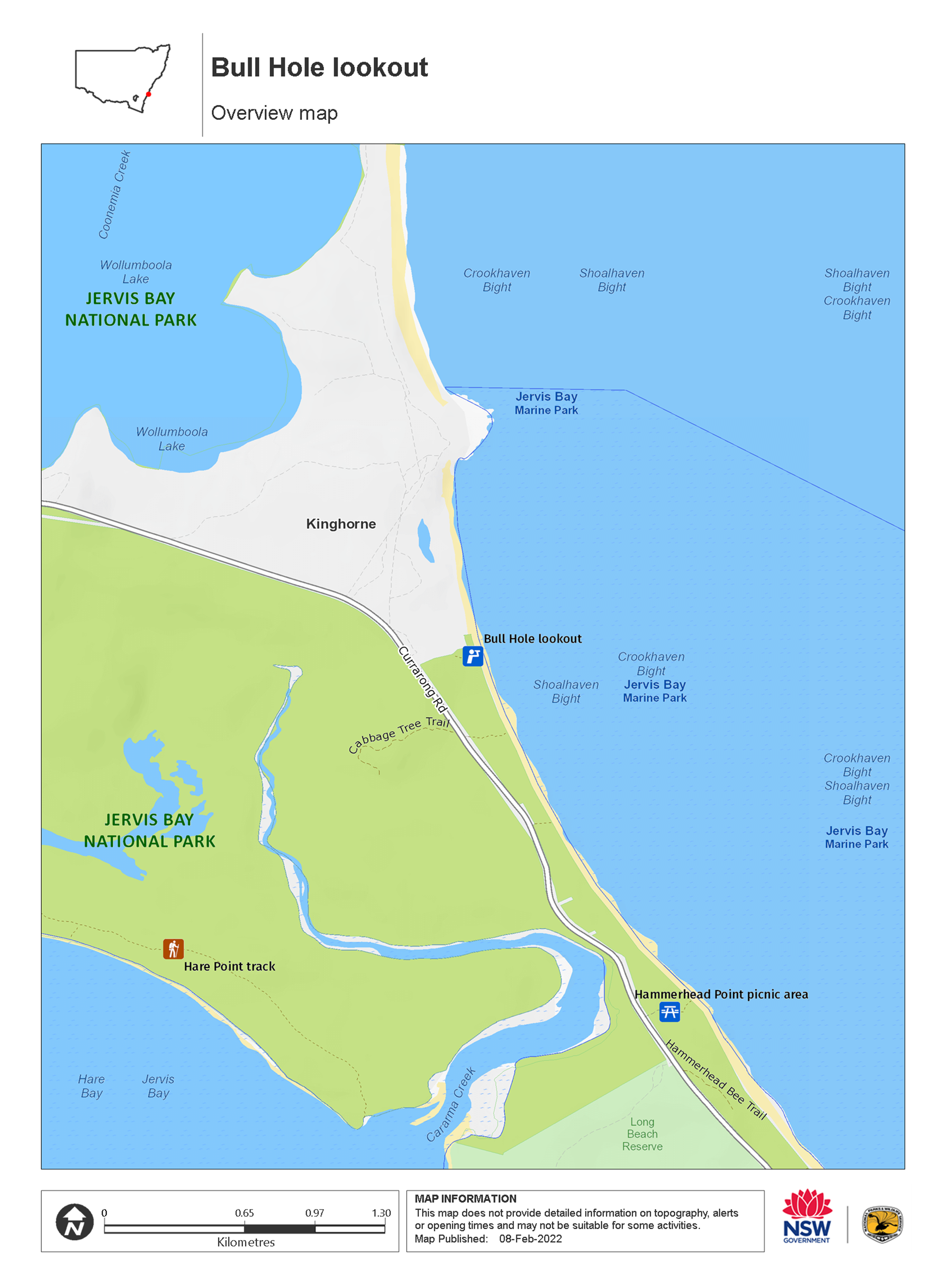
Map legend
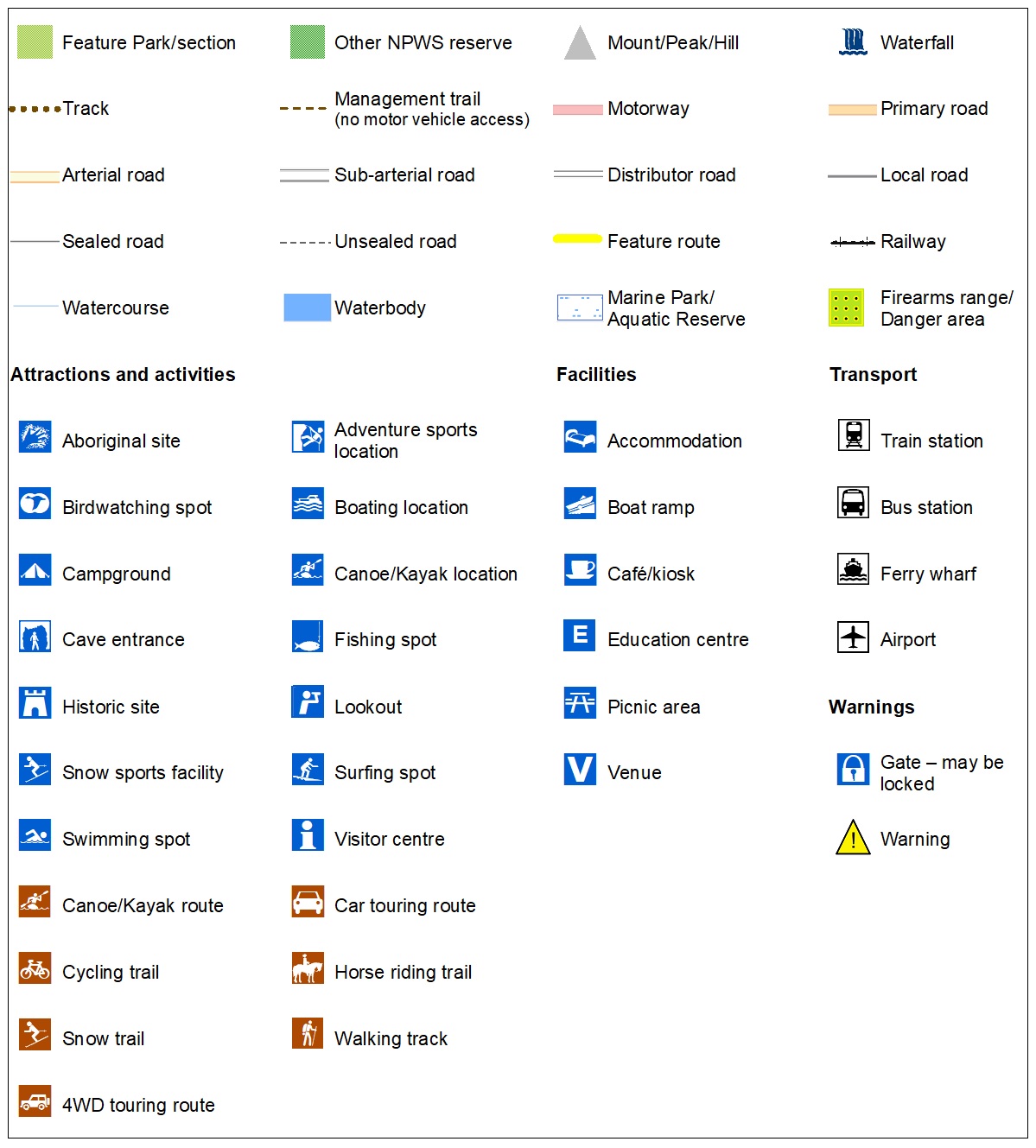
Local alerts
For the latest updates on fires, closures and other alerts in this area, see https://www.nationalparks.nsw.gov.au/things-to-do/lookouts/bull-hole-lookout/local-alerts
General enquiries
- National Parks Contact Centre
- 7am to 7pm daily
- 1300 072 757 (13000 PARKS) for the cost of a local call within Australia excluding mobiles
- parks.info@environment.nsw.gov.au
Park info
- in Jervis Bay National Park in the South Coast region
Jervis Bay National Park is always open but may have to close at times due to poor weather or fire danger.
Visitor info
All the practical information you need to know about Bull Hole lookout.
Getting there and parking
Bull Hole lookout is in the northern precinct of Jervis Bay National Park. To get there:
- Travel south through Nowra on Princes Highway
- Turn left off Princes Highway at Forest Road - follow the signs to Currarong.
- Continue in a generally easterly direction. Once you’re on Currarong Road, travel approximately 6.4km before taking the small dirt track set amongst casuarinas hard on your left.
- Follow the dirt track for approximately 200m to the carpark
Road quality
- Unsealed roads
Vehicle access
- 2WD vehicles (no long vehicle access)
Weather restrictions
- All weather
Parking
Parking is available a very short walk from the attraction. The carpark is small and the road into the carpark is narrow and winding, so it’s not suitable for trailers, caravans, campervans or long vehicles. Such vehicles would need to park on Currarong Road and walk in to the site (approximately 250m). It can be a busy place on the weekend, so parking might be limited.
Best times to visit
There are lots of great things waiting for you Jervis Bay National Park. Here are some of the highlights.
Spring
Take advantage of spring weather and head to Hyams Beach. You can pick up some fish and chips from the nearby Hyams Beach Café to enjoy on the white sands of this iconic south coast beach. If you're feeling energetic after lunch, walk the easy Hyams Beach trail.
Summer
Swim, surf, snorkel and dive your way through the summer school holidays in this beach paradise.
Winter
Humpback whales can be spotted migrating northwards in the winter months. Keep an eye out for southern right whales and dolphins too. They're often seen around the park's coastline.
Weather, temperature and rainfall
Summer temperature
Average
17°C and 24°C
Highest recorded
40.6°C
Winter temperature
Average
10°C and 17°C
Lowest recorded
-0.5°C
Rainfall
Wettest month
April, May and June
Driest month
September
The area’s highest recorded rainfall in one day
316.7mm
Facilities
Carpark
Maps and downloads
Permitted
Fishing
A current NSW recreational fishing licence is required when fishing in all waters.
Prohibited
Pets
Pets and domestic animals (other than certified assistance animals) are not permitted. Find out which regional parks allow dog walking and see the pets in parks policy for more information.
Smoking
NSW national parks are no smoking areas.
Learn more
Bull Hole lookout is in Jervis Bay National Park. Here are just some of the reasons why this park is special:
Ancient connections
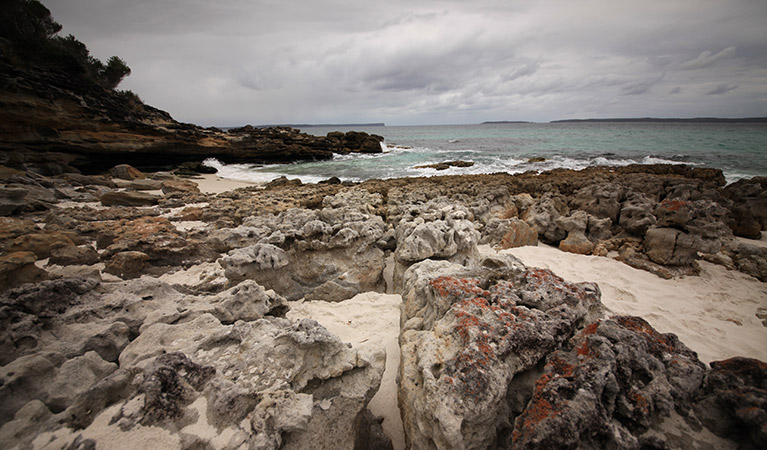
Jervis Bay sits within the lands of the South Coast (Yuin) Aboriginal people of the Dharawal-Dhurga language group. Research shows the area has the highest density and most diverse range of archaeological site types anywhere on the south coast, making this precious park an important place for the preservation of Aboriginal sites, like coastal middens, stone artefacts, rock art, and axegrinding grooves.
- Then and now: Aboriginal culture Then and now: Aboriginal culture is a Stage 2 (Years 3-4) school excursion in Jervis Bay National Park, focusing on HSIE. Through story and creative expression, the life and culture of the local people are shared.
- Then and now: Aboriginal culture Aboriginal culture then and now is a Stage 1 (Years 1-2) school excursion in Jervis Bay National Park, focusing on Geography and History. Through story and creative expression, the life and culture of the local people are shared.
- Then and now: Aboriginal culture Then and now: Aboriginal culture is a Stage 3 (Years 5-6) school excursion at Jervis Bay National Park, focusing on HSIE. Through story and creative expression, the life and culture of the local people are shared.
- Then and now: Aboriginal culture Then and now: Aboriginal culture is an Early Stage 1 (Kindergarten) school excursion in Jervis Bay National Park, focusing on HSIE. Through story and creative expression, the life and culture of the local people are shared.
Diverse habitats
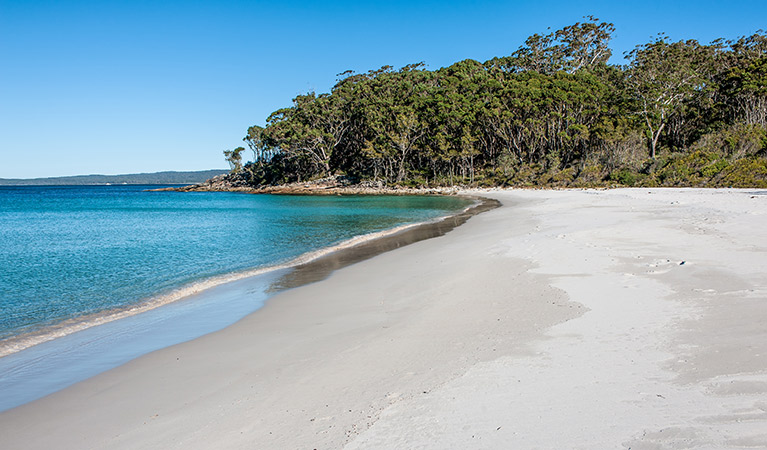
A walk through the park reveals its varied vegetation – from endangered bangalay sand forests to ubiquitous eucalypt woodlands. In the park’s protected gullies you’ll spot rainforest species like lilly pilly and water vine. And if you stop by Carama Inlet or Moona Moona creek, you’ll see saltmarsh and mangroves. Be ready to spot plenty of wildlife among coastal heathland on the sandstone plateau near Vincentia, as well as unique flora in the park’s northern clay-soiled heath.
Picture-perfect beaches

Arriving in this pristine haven, you could be forgiven for thinking you’re in paradise. The region's crystal clear waters and impossibly white sand are among its biggest drawcards – the sea is ideal for fishing, swimming and snorkelling. Be sure to enjoy a wander along Hyams Beach to experience its icing-sugarsand – it’s said to be the world’s whitest.
- Coonemia Creek Coonemia Creek in Jervis Bay National Park is a great spot for fishing, kayaking, birdwatching or a picnic.
- Greenfield Beach picnic area Greenfield Beach picnic area in Jervis Bay National Park is perfect for a barbecue. After a tasty lunch, go for a walk or head down to the beach for a swim or snorkel.
Protected birds
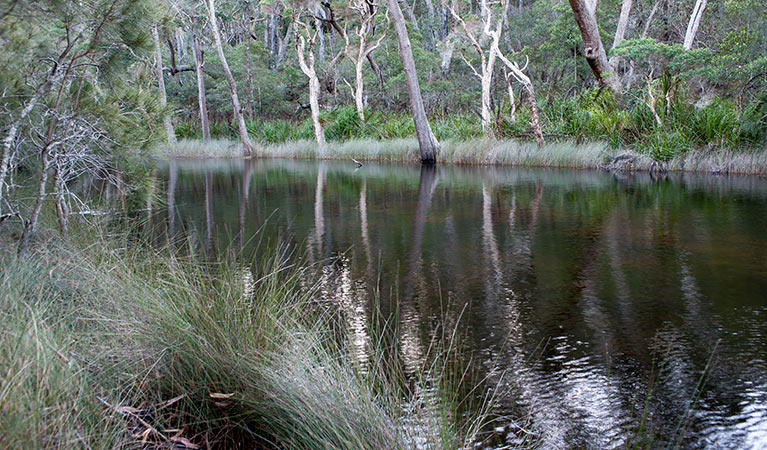
This gorgeous landscape is home to several threatened bird species that dependon the park for survival. The chance of seeing these special birds thriving makes the park a must for everyone, not just birdwatchers. Head to Lake Wollumboola to see waders and water birds or visit the heathland areas, which support eastern bristlebirds and ground parrots. You might see glossy black cockatoos among casuarina forest and powerful owls in woodland.
- Hyams Beach trail Hyams Beach trail, also known as the Bird Spotter’s walk is great for birdwatching in Jervis Bay National Park. Continue the walk to Seamans Beach for a refreshing swim, and loop back along Hyams Beach.
Plants and animals protected in this park
Animals
-

Yellow-tailed black cockatoo (Calyptorhynchus funereus)
The yellow-tailed black cockatoo is one of the largest species of parrot. With dusty-black plumage, they have a yellow tail and cheek patch. They’re easily spotted while bird watching, as they feed on seeds in native forests and pine plantations.
-

Sugar glider (Petaurus breviceps)
The sugar glider is a tree-dwelling Australian native marsupial, found in tall eucalypt forests and woodlands along eastern NSW. The nocturnal sugar glider feeds on insects and birds, and satisfies its sweet tooth with nectar and pollens.
-

Eastern ground parrot (Pezoporus wallicus wallicus)
The eastern ground parrot is a beautiful, ground-dwelling native bird that lives in low heathland habitat along the NSW North and South coasts and escarpments. It’s listed as a vulnerable species in NSW.
-

White-bellied sea eagle (Haliaeetus leucogaster)
White-bellied sea eagles can be easily identified by their white tail and dark grey wings. These raptors are often spotted cruising the coastal breezes throughout Australia, and make for some scenic bird watching. Powerful Australian birds of prey, they are known to mate for life, and return each year to the same nest to breed.
-

Australian pelican (Pelecanus conspicillatus)
The curious pelican is Australia’s largest flying bird and has the longest bill of any bird in the world. These Australian birds are found throughout Australian waterways and the pelican uses its throat pouch to trawl for fish. Pelicans breed all year round, congregating in large colonies on secluded beaches and islands.
Plants
-

Black sheoak (Allocasuarina littoralis)
The black sheoak is one of a number of casuarina species found across the east coast of Australia and nearby tablelands. Growing to a height of 5-15m, these hardy Australian native plants can survive in poor or sandy soils. The barrel-shaped cone of the black sheoak grows to 10-30mm long.
-

Scribbly gum (Eucalyptus haemastoma)
Easily identifiable Australian native plants, scribbly gum trees are found throughout NSW coastal plains and hills in the Sydney region. The most distinctive features of this eucalypt are the ‘scribbles’ made by moth larva as it tunnels between the layers of bark.
